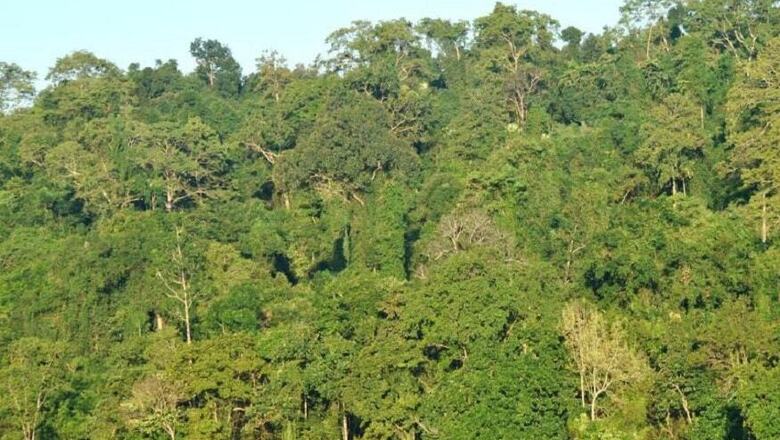
views
One of the biggest conservation challenges in 2020 was to protect the biodiversity in Dehing Patkai sub-tropical rainforest of Assam against coal mining industries, and it has finally turned out to be a good year for the Wildlife Sanctuary that would soon be upgraded to a ‘National Park’.
The Assam government on Monday resolved to grant National Park status to Dehing Patkai - a decision announced by Chief Minister Sarbananda Sonowal after deliberation with wildlife officials.
“Our Govt has decided to upgrade the Dehing Patkai Wildlife Sanctuary in Assam, which is home to a vast variety of flora and fauna, to a National Park.
In a meeting with senior officials in Guwahati today, I have directed them to take necessary steps in this regard,” Sonowal tweeted.
Our Govt has decided to upgrade the Dehing Patkai Wildlife Sanctuary in Assam, which is home to a vast variety of flora and fauna, to a National Park. In a meeting with senior officials in Guwahati today, I have directed them to take necessary steps in this regard. pic.twitter.com/cUV5HKBwPb— Sarbananda Sonowal (@sarbanandsonwal) July 6, 2020
Environmentalists celebrated the news as a ‘great victory’ though they unanimously sought the inclusion of Joypur Reserve Forest (RF) in Dibrugarh district into the wildlife landscape of Dehing Patkai as ‘protected area’.
Soumyadeep Dutta, a renowned conservationist and president of Nature’s Beckon, the environmental organisation that spearheaded a movement for the protection of the lowland rainforest and local communities welcomed the move while advocating an ‘area expansion’.
“The Chief Minister has supported our movement. We welcome the conversion of Dehing Patkai to a National Park, but there should also be area expansion. The Joypur RF is one of the most valuable assets of Dehing Patkai - a gem, in fact. But it falls outside the sanctuary. If it is not brought under protected area, it will never have a legal status. It should be included in the 500 sq km - the balance area of the original proposal we submitted in 1994,” said Dutta.
He added that Joypur RF should have more personnel and as of now, the Dibrugarh Forest division is protecting it.
"It needs more infrastructure, protection camps. It was declared an elephant reserve in 2003 and has no legal status. In 2004, an area of 111.19 sq km was declared as sanctuary,” said Dutta.
Forest officials welcomed the move and hoped that it would meet the needs to sustain a better social-ecological future.
Pradipta Baruah, Divisional Forest Officer of Dibrugarh district was also of the view that the Joypur RF must be made a part of the sanctuary. Joypur is one of the major habitats for elephants, the Hoolock Gibbon - the only ape found in India, Giant Flying Squirrels and Clouded Leopards.
“Without the inclusion of Joypur, this would remain incomplete. At present, only Joypur RF is left intact with no intervention from miscreants. It is a beautiful forest in Dibrugarh spread over an area of 108 sq km and rich in biodiversity,” said DFO Baruah.
Echoing similar views, the environmental activists want the government to notify the ‘balance area’ of several reserve forests in Sivasagar, Dibrugarh and Tinsukia districts as Wildlife Sanctuary.
“It's wonderful news, and am hoping that the balance area is notified as a wildlife sanctuary soon. This entire 500 sq km area of Dirok, Upper Dehing and Joypur forest reserves is contiguous and there are no land settlements. If the balance area is notified as a Wildlife Sanctuary and included in the government proposal, the area surrounding it, even though degraded in many parts, can act as a buffer zone. Also, if no anthropogenic activities are allowed there, in time there might be regeneration of forests,” said activist Bhaskar J Barua of NGO Kaziranga Foundation.
“The government’s intention to upgrade Dehing Patkai to a National Park is welcome. However, I feel that adjoining patches of forests of the wildlife sanctuary including Joypoore RF must be included within the ambit of National Park,” said Dr Bibhab Talukdar, Secretary General and CEO of Aaranyak, a Wildlife NGO based in Guwahati.
The state government was under pressure from several wildlife and conservation NGOs that were seeking a complete ban on coal mining, pointing to the large-scale denudation of forest land within the Dehing Patkai Elephant Reserve due to years of mining.
A public interest litigation was filed in Gauhati High Court on May 26 by advocate Mrinmoy Khataniar and mountaineer Amar Jyoti Deka against the Centre’s approval to Coal India for mining inside Dehing Patkai rainforest. The team now wants World Heritage Site status for Dehing Patkai as it is upgraded into a National Park.
“This was one of our prayers. Other reserved forests are a contiguous area - including the bordering areas of Arunachal Pradesh comprising Tirap and Changlang districts. Now, enhanced legal protection comes in with National Park status. Dehing Patkai will now get better protection. This was long overdue,” remarked advocate Debajit Das who moved the writ petition in court.
“Dehing Patkai should be declared a World Heritage site because of its biodiversity. It is home to rare species of cats, amphibians, reptiles, avian life including the endangered white-winged wood duck besides an exotic variety of plants and orchids. The struggle is not yet over. There should be a strict moratorium on mining and compensation should be sought for the damage done,” Das further mentioned.
In 2012, Coal India Limited (CIL) had submitted a proposal for diversion of 98.59 Hectares (Ha) land in Saleki Proposed Reserve Forest (PRF) for mining lease under the Tikok Open Cast Project. There are a number of elephant corridors in and around the Saleki PRF, which is a part of Dehing Patkai Elephant Reserve within the Wildlife Sanctuary.
The PIL highlighted how the North-Eastern Coalfields (NECF), a unit of CIL had carried out illegal mining for several years in the 73.2 Ha forest land - a fact that came to light after a site inspection report submitted in November 2019 by the Shillong regional office of the Union Ministry of Environment, Forests and Climate Change (MoEF&CC). The Assam forest department had also imposed a penalty of Rs 43.25 crore on CIL for carrying out illegal mining inside the elephant reserve between 2003 and 2019.
Despite this, the National Board for Wildlife (NBWL) in April 2020 granted approval for mining in a broken area of 57.20 Ha of forest land in Saleki PRF - where the CIL had carried out mining in 2012 before applying for a renewal of lease and forest clearance.
This was in violation of the Forest Conservation Act of 1980 that mandates environmental clearance prior to undertaking any non-forest activity in a reserve forest. The PIL also mentioned how NWBL overlooked the site inspection report that exposed how illegal mining was carried out on the ‘unbroken’ land of the remaining 16 hectares.
Meanwhile, the celebration continued to build with people expressing their thoughts through social media posts.
“This is great news. Very heartening to see people's campaign coming to a fruition - it suggests the government is listening. But the area should be at least 500 sq km or more so that all the last remaining patches of Assam valley wet rainforest is brought under protection,” wrote Chitta Ranjan Pathak, an Assamese living in Australia and the author of ‘The Elephant Girl’.
“I am Dehing Patkai
And Saleki
I am the Dibang Valley
I am Earth
Walk on me not all over me
Cherish me while you still can,” wrote Mehnaz Ummeid Ali, an Assamese entrepreneur and artist living in Hyderabad.



















Comments
0 comment